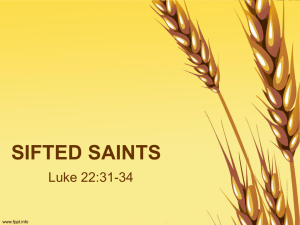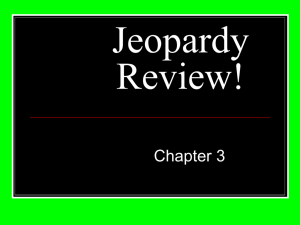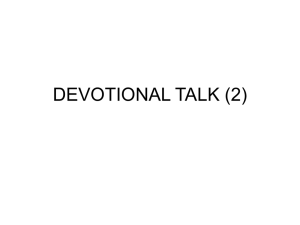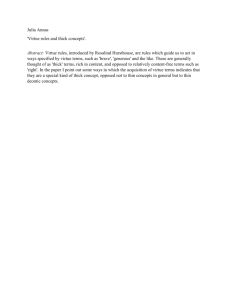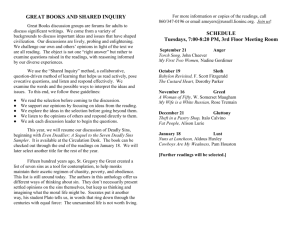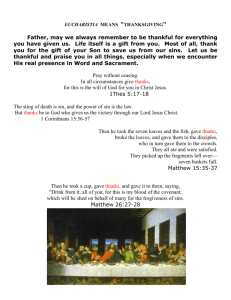Chapter 9: The First Commandment
advertisement
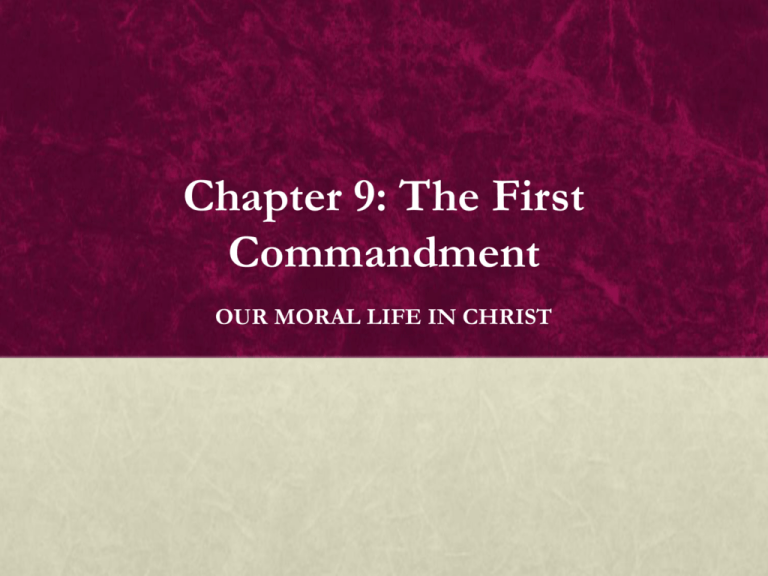
Chapter 9: The First Commandment OUR MORAL LIFE IN CHRIST Introduction (pp. 200-202) ANTICIPATORY SET After reading the story of Peter and Rebecca, respond in writing to the following question, and then discuss: Did Peter do the right thing by breaking up with Rebecca? Introduction (pp. 200-202) BASIC QUESTIONS What is the First Commandment? KEY IDEAS The First Commandment obliges everyone to believe in God, trust in God, and love God. Introduction (pp. 200-202) FOCUS QUESTIONS What was distinctive about the Jews’ view of God? They believed there was only one God who completely transcends the world. What is the essence of the First Commandment? It is complete love for God. Introduction (pp. 200-202) FOCUS QUESTIONS Why is the obligation to love God above all things more than a mere command for Christians? Because God has loved us first and drawn near to us, we should respond to him with love. What are the two parts of the Decalogue? The first three Commandments deal with love of God. The final seven deal with love of neighbor. Introduction (pp. 200-202) GUIDED EXERCISE Work with a partner to examine and explain the following statement: The theological virtues “have God for their origin, their motive, and their object.” Introduction (pp. 200-202) GUIDED EXERCISE Think/Pair/Share on the following question: Why does it make sense that the First Commandment of the Decalogue is both the First and the Greatest? Introduction (pp. 200-202) FOCUS QUESTIONS Where does the work of evangelization normally take place? It takes place in the family, in the workplace, and in social relations. What gives us the power to believe in, trust, and love God beyond our natural powers? Sanctifying grace provides the supernatural virtues of faith, hope, and charity. Introduction (pp. 200-202) HOMEWORK ASSIGNMENT Study Questions 1-6 (p. 221) Workbook Questions 1-3 Read “Faith” through “Sins Against Faith” (pp. 203-205) Introduction (pp. 200-202) CLOSURE Write a paragraph defining the First Commandment and discussing its relationship with the theological virtues. Introduction (pp. 200-202) ALTERNATIVE ASSESSMENT Revisit the Anticipatory Set of this lesson by writing about the following question: To what extent do you think Peter’s decision to break up with Rebecca is based on a rediscovery of the meaning of the First Commandment? 1. The Virtue of Faith and Sins Against It (pp. 203-205) BASIC QUESTIONS What is faith? What are sins against faith? KEY IDEAS Faith is a supernatural gift by which we freely accept Divine Revelation as interpreted and taught by the Catholic Church. The five sins against faith are voluntary doubt, schism, heresy, apostasy, and atheism. 1. The Virtue of Faith and Sins Against It (pp. 203-205) ANTICIPATORY SET Write for five minutes, paraphrasing the quote on faith from Spe Salvi. 1. The Virtue of Faith and Sins Against It (pp. 203-205) GRAPHIC ORGANIZER Fill out the following to organize their knowledge of the sins against faith. 1. The Virtue of Faith and Sins Against It (pp. 203-205) 1. The Virtue of Faith and Sins Against It (pp. 203-205) GUIDED EXERCISE Think/Pair/Write/Share on the following question: Of the five sins against faith, which do you consider the most serious, and why? 1. The Virtue of Faith and Sins Against It (pp. 203-205) FOCUS QUESTIONS What is faith, according to CCC 1814? It is “the theological virtue by which we believe in God and all that he has said and revealed to us, and that Holy Church proposes for our belief.” Why is it important for an uninformed Catholic to avoid reading just anything? Even though every challenge to the Faith can be successfully answered, an uninformed Catholic could have his or her faith damaged or even destroyed by reading bad material. 1. The Virtue of Faith and Sins Against It (pp. 203-205) FOCUS QUESTION Why is it not unreasonable to demand that a Catholic humbly accept a point of doctrine he or she cannot understand? Because the Church possesses an infallible teaching authority and because some of the content of Revelation exceeds the capacity of reason, it is reasonable to accept the Church’s direction over one’s own, limited understanding. 1. The Virtue of Faith and Sins Against It (pp. 203-205) FOCUS QUESTIONS How does free will relate to the virtue of faith? God offers this gift to every person, but it is up to each individual to accept or reject it. How is the gift of faith available to a person who has not even heard of Christ or God? Through grace, God gives every person the possibility of knowing him and accepting him. 1. The Virtue of Faith and Sins Against It (pp. 203-205) HOMEWORK ASSIGNMENT Study Questions 7-10 (p. 221) Practical Exercises 12-13 (p. 222) Workbook Questions 4-11 Read “Hope” through “Sins Against Hope” (pp. 205-206) 1. The Virtue of Faith and Sins Against It (pp. 203-205) CLOSURE Write a paragraph identifying and defining the sins against faith, using the Graphic Organizer on page 202. 2. The Virtue of Hope and Sins Against It (pp. 205-206) ANTICIPATORY SET Try to define in writing what the virtue of optimism is and whether you consider yourselves optimists. 2. The Virtue of Hope and Sins Against It (pp. 205-206) BASIC QUESTIONS What is hope? What does hope demand of us? What are sins against hope? KEY IDEAS Hope is the theological virtue by which one looks forward to the happiness of eternal life with God, placing his or her trust in Christ’s promises and relying on the grace of the Holy Spirit to achieve it. We must freely hope in God’s mercy, but at the same time not take it for granted. The sins against hope are despair, which is the defect of hope, and presumption, which is the excess of hope. 2. The Virtue of Hope and Sins Against It (pp. 205-206) FOCUS QUESTIONS What attribute of God does the virtue of hope give us the capacity to trust? We can trust in God’s mercy. What do we trust will be the result of God’s mercy on us? We trust that God has the mercy to give us all the graces we need to reach salvation and achieve full union with him. 2. The Virtue of Hope and Sins Against It (pp. 205-206) FOCUS QUESTIONS Besides trust in God, what does the virtue of hope require from us? It requires our voluntary efforts to use all the means at our disposal and to rely strongly on God’s assistance. How does hope, which is focused on the future, help us in the present? We can accept and live the difficulties of the present if we see them as leading to a great future. 2. The Virtue of Hope and Sins Against It (pp. 205-206) GRAPHIC ORGANIZER Complete the following table to describe CCC 1818 in terms of the positive qualities that hope fosters and the negative qualities that hope diminishes. 2. The Virtue of Hope and Sins Against It (pp. 205-206) 2. The Virtue of Hope and Sins Against It (pp. 205-206) FOCUS QUESTIONS What is presumption? Presumption is the sin either of (a) expecting salvation without personal effort or (b) trusting solely in one's own efforts to be saved without God’s aid. Why is presumption a sin? Either one presumes that God will save the individual without the person making an effort or the person does not think he or she needs God’s help. Both flow out of pride. 2. The Virtue of Hope and Sins Against It (pp. 205-206) FOCUS QUESTIONS How is despair an unreasonable lack of hope and presumption an unreasonable excess of hope? Despair assumes that one’s sins are too grave to be forgiven. Presumption assumes one’s sins are too unimportant to be condemned. What are sins against hope? Despair is the defect of hope, and presumption is the excess of hope. 2. The Virtue of Hope and Sins Against It (pp. 205-206) FOCUS QUESTIONS What is despair? The loss of hope in God is caused by doubting in his fidelity, care for people, or power to save a sinner. Why is despair a sin? It is a voluntary loss of hope due to pride. We subordinate God’s mercy to our own perception of the magnitude of our sin or to our own opinion of the extent of God’s love. 2. The Virtue of Hope and Sins Against It (pp. 205-206) GUIDED EXERCISE Think/Pair/Share on how the following is a sin of presumption: A Catholic girl decides to have sexual relations with her boyfriend on Friday night, reasoning that she will just go to Confession on Saturday to take care of the sin. 2. The Virtue of Hope and Sins Against It (pp. 205-206) GUIDED EXERCISE Read Matthew 27:3-5 and free write on the following question: Why does Judas seem to be guilty of the sin of despair? 2. The Virtue of Hope and Sins Against It (pp. 205-206) HOMEWORK ASSIGNMENT Study Questions 11-12 (p. 221) Workbook Questions 12-16 Read “Charity” through “Sins Against Charity” (pp. 206-207) 2. The Virtue of Hope and Sins Against It (pp. 205-206) CLOSURE Write a paragraph explaining and illustrating the sins against hope. 2. The Virtue of Hope and Sins Against It (pp. 205-206) ALTERNATIVE ASSESSMENT Read Matthew 27:5 and John 21:15-19, and free write on the following question: How do the actions of St. Peter and Judas illustrate hope and sins against hope? 3. The Virtue of Charity and Sins Against It (pp. 206-207) BASIC QUESTIONS What is charity? What are sins against charity? KEY IDEAS Charity is the theological virtue by which a Christian loves God above all things and his or her neighbor as himself or herself. The sins against charity include indifference, ingratitude, lukewarmness, spiritual sloth, and hatred of God. 3. The Virtue of Charity and Sins Against It (pp. 206-207) ANTICIPATORY SET Incorporate Supplementary Reading 3 (p. 214) into the Opening Prayer. This is St. Paul’s great hymn on charity (cf. 1 Cor 13:1-13). 3. The Virtue of Charity and Sins Against It (pp. 206-207) GUIDED EXERCISE Perform a paragraph shrink on the paragraph beginning, “Which love should be given priority…” (p. 206). 3. The Virtue of Charity and Sins Against It (pp. 206-207) FOCUS QUESTION What is charity? It is the theological virtue by which a Christian loves God above all things for God’s own sake and loves his or her neighbor as himself or herself for the love of God. 3. The Virtue of Charity and Sins Against It (pp. 206-207) FOCUS QUESTIONS What does the virtue of charity demand of us? It demands love as Jesus Christ loves his Father and every human being, to the point of laying down his life. Why should we love God above all things? It is the proper response to his having loved, created, and redeemed us. 3. The Virtue of Charity and Sins Against It (pp. 206-207) GUIDED EXERCISE Work with a partner to identify each sin against charity, define it, explain briefly why it is wrong, and provide a “symptom” of that sin. 3. The Virtue of Charity and Sins Against It (pp. 206-207) GUIDED EXERCISE Think/Pair/Share on the following question: With what forms of idolatry are teenagers tempted today? 3. The Virtue of Charity and Sins Against It (pp. 206-207) HOMEWORK ASSIGNMENT Study Questions 13-15 (p. 221) Practical Exercises 14-15 (p. 223) Workbook Questions 17-18 Read “The Worship of God: The Virtue of Religion” through “Sins Against Religion” (through “Idolatry”) (pp. 208-209) 3. The Virtue of Charity and Sins Against It (pp. 206-207) CLOSURE Write a well-organized paragraph on the five sins against charity. 3. The Virtue of Charity and Sins Against It (pp. 206-207) ALTERNATIVE ASSESSMENT Free write on which of the five sins against charity they consider the most serious and why. Briefly share responses. 4. The Virtue of Religion and Sins Against It (part one) (pp. 208-209) ANTICIPATORY SET Discuss the following question: Why should we worship God? 4. The Virtue of Religion and Sins Against It (part one) (pp. 208-209) BASIC QUESTIONS What is the virtue of religion? What are the four basic kinds of prayer? What is the basis of the sins against religion? What is idolatry? KEY IDEAS The virtue of religion is the prayerful actions of offering God praise, honor, and atonement, which, in justice, he deserves. The four basic kinds of prayer are adoration, thanksgiving, contrition, and petition. The sins against religion are deviations from the recognition of the one, true God as the only source of supernatural life. Idolatry is the worship or adoration, due God alone, paid to images “made with hands” or to any created object or being. 4. The Virtue of Religion and Sins Against It (part one) (pp. 208-209) FOCUS QUESTIONS What is the virtue of religion? It is the prayerful action of offering God praise, honor, and atonement, which, in justice, he deserves. Why should we worship God? Worship of God is the natural and proper human response to God due to his exalted and transcendent dignity and his infinite love for us. 4. The Virtue of Religion and Sins Against It (part one) (pp. 208-209) GUIDED EXERCISE Write an example of each of the four kinds of prayer. 4. The Virtue of Religion and Sins Against It (part one) (pp. 208-209) FOCUS QUESTIONS What is the basis of sins against religion? The basis of sins against religion is some deviation from the recognition of God as the only source of supernatural life. What is idolatry? It is the worship or adoration, due to God alone, paid to images “made with hands” or to any created object or being. 4. The Virtue of Religion and Sins Against It (part one) (pp. 208-209) FOCUS QUESTIONS Why is idolatry a sin? Because God is the only God. Why is the Catholic veneration of images of God and the saints not a form of idolatry? Catholics show respect and honor to the person the image represents, not the image itself. Veneration, moreover, is different from adoration. We venerate, or honor the saints, but we adore, or worship, only God. 4. The Virtue of Religion and Sins Against It (part one) (pp. 208-209) HOMEWORK ASSIGNMENT Study Questions 16-20 (p. 221) Practical Exercises 1-11 (p. 222) Workbook Questions 19-22 Read (finish) “Sins Against Religion” through “Conclusion” (pp. 209213) 4. The Virtue of Religion and Sins Against It (part one) (pp. 208-209) CLOSURE Write a paragraph defining the virtue of religion and the four kinds of prayer proper to this virtue. 4. The Virtue of Religion and Sins Against It (part one) (pp. 208-209) ALTERNATIVE ASSESSMENT Complete Practical Exercise 11 (p. 222) to identify the kinds of prayer found in the Lord’s Prayer. 5. Sins Against Religion (part two) (pp. 209-213) ANTICIPATORY SET Incorporate into the Opening Prayer each of the forms of prayer. 5. Sins Against Religion (part two) (pp. 209-213) BASIC QUESTIONS What are superstition, divination, magic, irreligion, and satanic worship? KEY IDEAS Superstition consists of any belief or practice that offers improper worship to God. Divination is the use of occult powers and practices in an attempt to predict the future or to obtain information that cannot be discovered through normal channels. Magic involves seeking occult forces through rituals or formulas as a means to obtain either a good or evil effect. Irreligion consists of disrespect and, in many instances, mockery of God’s goodness and sacred dignity through tempting God, sacrilege, or simony. Satanic worship is the direct worship of the devil and is one of the most dreadful sins against the virtue of religion. 5. Sins Against Religion (part two) (pp. 209-213) FOCUS QUESTIONS What is superstition? It is an irrational religious belief or practice founded on fear or ignorance. Various forms, such as good-luck charms, omens, divination, and magic, are forbidden by the First Commandment as improper worship of God. What is wrong with superstition? Superstition indicates the belief that objects or practices have powers in themselves and can be used to manipulate God’s infinite wisdom and love. 5. Sins Against Religion (part two) (pp. 209-213) FOCUS QUESTIONS What is divination? It is the use of occult powers and practices in an attempt to predict the future or to obtain information that cannot be discovered through normal channels. Why are some legitimately able to know the future or read people’s souls? Some saints could foretell future events or read hearts through a special divine illumination. If a person attempts to gain hidden information from a source other than God, with whom is he or she likely to be dealing? They are demonic powers. 5. Sins Against Religion (part two) (pp. 209-213) GRAPHIC ORGANIZER Complete the following table to organize your knowledge about the sins of irreligion. 5. Sins Against Religion (part two) (pp. 209-213) 5. Sins Against Religion (part two) (pp. 209-213) GUIDED EXERCISE Think/Pair/Share on the following question: What is behind divinization, according to CCC 2116? 5. Sins Against Religion (part two) (pp. 209-213) FOCUS QUESTIONS What is magic? It is the pretended art of influencing the course of events and producing physical phenomena by actions attributed to spiritual beings. Why is magic wrong? It is wrong because it is an attempt to obtain something outside the means God permits, and it may also be used to try to harm another person. 5. Sins Against Religion (part two) (pp. 209-213) FOCUS QUESTIONS What is irreligion? It is disrespect and, in many instances, mockery of God’s goodness and sacred dignity. The more common sins of irreligion are tempting God, sacrilege, and simony. What is satanic worship? It is direct worship of the Devil. 5. Sins Against Religion (part two) (pp. 209-213) FOCUS QUESTIONS What is the gravity of the sin of satanic worship? It is a horrific sin to worship an evil being who is the enemy of God and who wishes to destroy the possibility of our salvation. What is the Old Testament attitude toward satanic worship? These practices are strictly forbidden. What is the New Testament attitude toward satanic worship? It is also condemned. 5. Sins Against Religion (part two) (pp. 209-213) HOMEWORK ASSIGNMENT Practical Exercises 16-20 (p. 223) Workbook Questions 23-28 Read “Religious Liberty” through “The ‘New Age’ Movement” (pp. 216-218) 5. Sins Against Religion (part two) (pp. 209-213) CLOSURE Write a paragraph summarizing each of the sins against religion in one sentence each. 5. Sins Against Religion (part two) (pp. 209-213) ALTERNATIVE ASSESSMENT Discuss the content of the traditional prayer to St. Michael and conclude class by reciting this prayer. 6. Advanced Concepts: Religious Liberty and the “New Age” Movement (pp. 216-218) BASIC QUESTIONS What is the basis of religious liberty? What are the errors of the New Age movement? KEY IDEAS Each person has the right to worship God in public and private free from coercion. The New Age movement is an amalgam of beliefs, including some Christian ones, which contradict the Catholic Faith, and so, is a sin against the First Commandment. Its errors include monism, pantheism, syncretism, and Gnosticism. 6. Advanced Concepts: Religious Liberty and the “New Age” Movement (pp. 216-218) ANTICIPATORY SET Repeat the Anticipatory Set from the last lesson to reinforce the four types of prayer. 6. Advanced Concepts: Religious Liberty and the “New Age” Movement (pp. 216-218) FOCUS QUESTIONS What is the duty of society in regard to religious liberty? Society has to recognize, facilitate, and defend the right of people to practice religion. What is the only limit society can place on public religious worship? Society can only require that “the just requirement of public order” be observed. 6. Advanced Concepts: Religious Liberty and the “New Age” Movement (pp. 216-218) FOCUS QUESTION What do the United Nations and the U.S. Constitution say about religious liberty? The U.N. Universal Declaration on the Rights of Man says that “Everyone has the right to freedom of thought, conscience, and religion; this right includes freedom…either alone or in his community with others and in public or private, to manifest his religion or belief in teaching, practice, worship and observance.” The First Amendment of the U.S. Constitution says that “Congress shall make no law respecting an establishment of religion, or prohibiting the free exercise thereof.” 6. Advanced Concepts: Religious Liberty and the “New Age” Movement (pp. 216-218) GUIDED EXERCISE Work with a partner to address the following question: What is the status of a law or court ruling that requires people to provide or cooperate in abortion, contraception, fertility services for homosexual “couples,” or homosexual adoption of children, according the United Nation’s Universal Declaration on the Rights of Man? 6. Advanced Concepts: Religious Liberty and the “New Age” Movement (pp. 216-218) FOCUS QUESTIONS What are some of the sources of the New Age movement? Ancient religious systems such as Gnosticism, oriental religions such as Buddhism and Hinduism, occult practices, and even modern science and psychology. Who was Alice Anne Bailey? She was a writer who died in 1949, who seems to have been a major inspiration for this movement. 6. Advanced Concepts: Religious Liberty and the “New Age” Movement (pp. 216-218) FOCUS QUESTIONS What are the two types of Christian apostates in the modern world? Those who believe nothing, and those who will believe anything. Is the New Age movement faithful to its sources? No. It dilutes and transforms the beliefs of the systems it draws from, keeping some and dropping others. 6. Advanced Concepts: Religious Liberty and the “New Age” Movement (pp. 216-218) FOCUS QUESTIONS What is the structure of the New Age movement? It is very loosely structured with no central organization. Why is New Age incompatible with the Catholic Faith? New Age beliefs are contrary to the First Commandment and to the Revelation that God has given to humanity. 6. Advanced Concepts: Religious Liberty and the “New Age” Movement (pp. 216-218) GRAPHIC ORGANIZER Complete the following table to organize the material on New Age errors. 6. Advanced Concepts: Religious Liberty and the “New Age” Movement (pp. 216-218) 6. Advanced Concepts: Religious Liberty and the “New Age” Movement (pp. 216-218) CLOSURE Write a paragraph explaining the principle of religious liberty as found in Vatican II, the U.N. Universal Declaration on the Rights of Man, and the First Amendment of the U.S. Constitution. 6. Advanced Concepts: Religious Liberty and the “New Age” Movement (pp. 216-218) HOMEWORK ASSIGNMENT Assign one or more of the Guided Exercises or other activities provided in this lesson that were not completed in class. 6. Advanced Concepts: Religious Liberty and the “New Age” Movement (pp. 216-218) ALTERNATIVE ASSESSMENT Write a well-organized paragraph on the principle errors of the New Age movement based on the Graphic Organizer in this lesson. THE END
